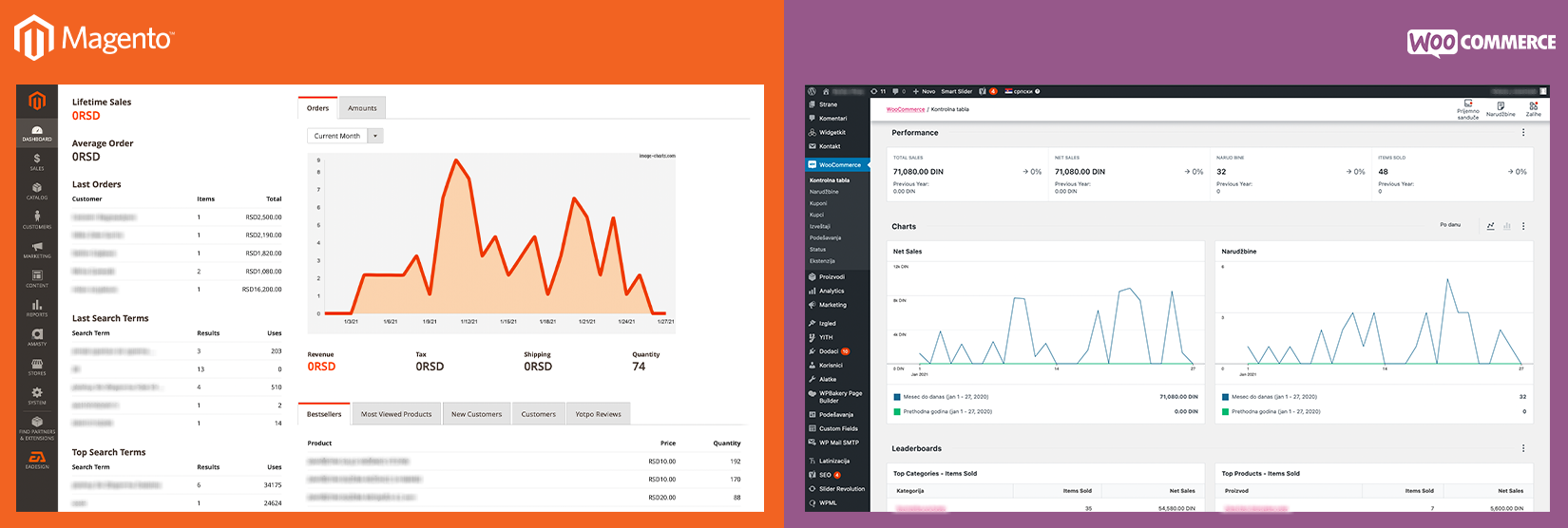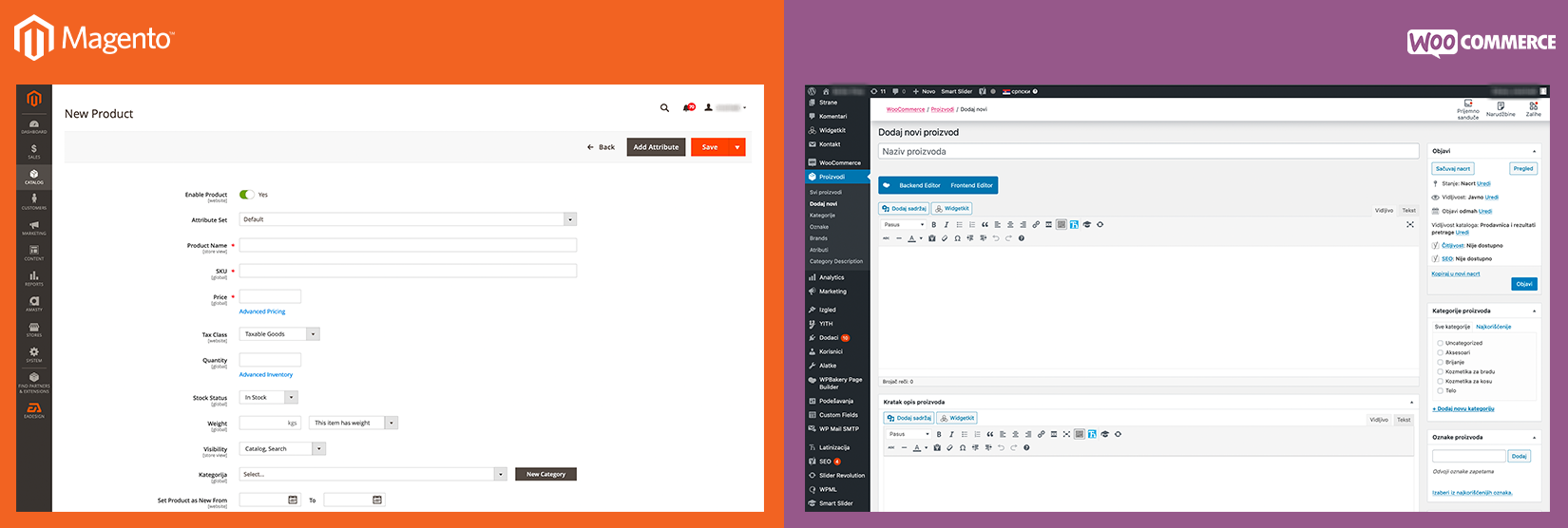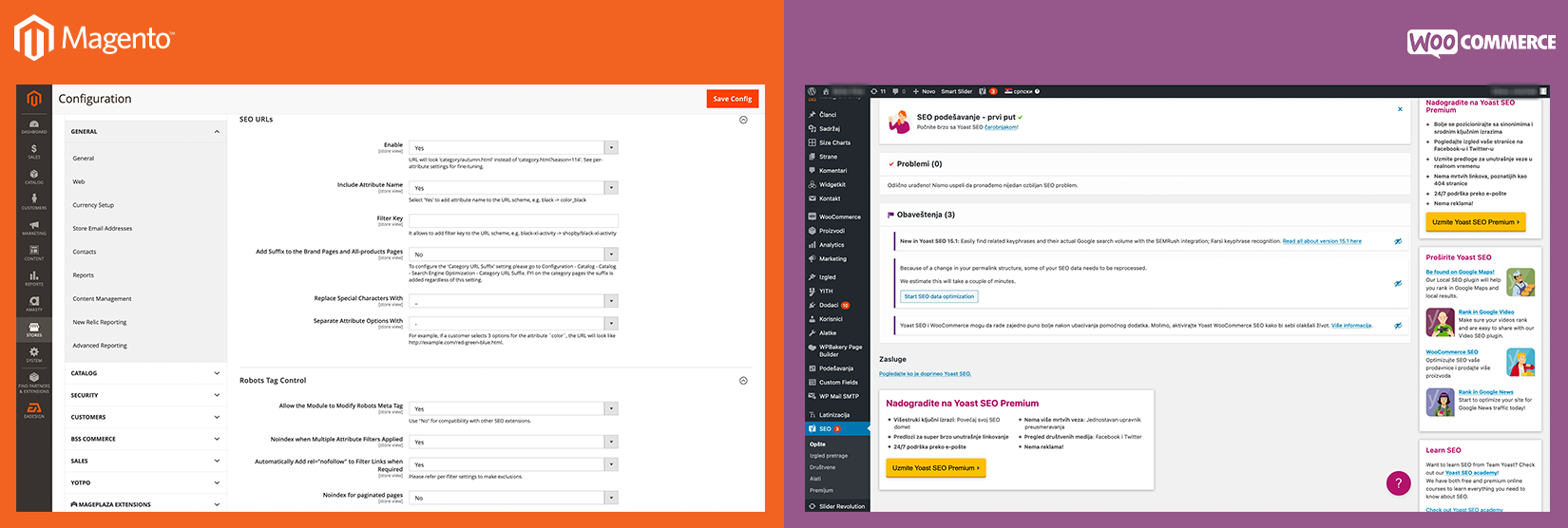As a company that is constantly developing multiple Magento 2 and WooCommerce online stores, we are often in the position to explain where we stand in the great Magento vs. WooCommerce debate.
This blog post offers a small systematization of our experiences.
Every successful online store starts its journey by choosing the e-commerce platform that makes the most sense for it. Clients often want to begin discussions about a new store with topics like deadlines and pricing, but these are all questions that can only be answered after selecting the e-commerce platform. Although we’ve launched over 100 online stores on both platforms in the past 10 years, it’s not always easy to recommend Magento or WooCommerce. While in some cases the optimal solution is clear, many mid-sized stores are “borderline cases,” and here, both options must be carefully considered.
Where will your site be in five years?
Choosing a platform is the first strategic decision a client makes, as it involves forecasting how the online store will evolve over time. We will always present our opinion on which option is better in the initial situation, but only the client can have the vision of where their store will be in five years. Whatever happens, it’s advisable to avoid switching platforms as long as the site’s design remains modern enough and there’s no need to create a completely new website. If the client has a clear vision or sees several alternative paths for the site’s development, each subsequent choice will be much easier. Magento 2 is a tailor-made solution for ambitious companies, as it can scale indefinitely. However, if the vision is more focused on developing a product story rather than creating a large store that supports 300 items in the cart, WooCommerce might be the better choice.

Magento 2 and WooCommerce Have a Lot in Common
Before we discuss the differences between the Magento 2 and WooCommerce platforms, we must emphasize that they represent two ways to achieve the same result—a store with nearly unlimited possibilities at the best possible price. Both platforms offer an impressive number of themes and plugins, so they can be customized and extended almost infinitely. Anything a client imagines, anything they’ve seen on other sites, already exists either as a basic feature or as an upgrade, especially when it comes to Magento. Both platforms also have very active communities that will quickly and freely help anyone with any issues they encounter. This is particularly important for WooCommerce sites that are fully managed by the client, because if the client feels technically skilled enough to manage the site themselves, they don’t need to pay for additional services.
Advantages of Open Source Solutions
Unlike other e-commerce platforms, such as Shopify and PrestaShop, Magento 2 and WooCommerce are considered open-source software. This means that developers around the world have access to the code, and they create add-ons and improvements daily. Those improvements that prove to be the best are incorporated into the next version of the software. Similar to the Android operating system, this leads to the refinement of the software, making it far more advanced than anything that can be created by a closed group of people. Very powerful tools that are not part of the core software can be purchased affordably as themes or plugins. This competition among developers to create useful tools and offer them to users over time has made Magento and WooCommerce the best e-commerce platforms.
WooCommerce is part of the WordPress platform for creating and managing websites, so it works with any popular WordPress theme, and it is easy to add new features by simply installing plugins. Magento, in its basic version, is free software (Magento Community Edition), and Adobe also offers paid versions, but these are not necessary for companies that operate locally or regionally, such as those in Serbia. These paid solutions are intended for global brands and merchants.

It is important to note that open-source solutions are the best choice for online store owners, precisely because they are free. This means that the client only pays for web hosting, the work of developers, and any additional themes or plugins they purchase, but not for the core software, which is the case with other e-commerce platforms.
Apples and Oranges: Can Magento 2 and WooCommerce Be Compared?
Magento and WooCommerce have grown and evolved in parallel over the past decade, and since the early versions, the debate over which of these two platforms is better has been ongoing. A large number of articles are dedicated to this topic, most of which are quite superficial and promote the following thesis:
“Magento is powerful but complicated. The work of a developer to set up the Magento platform is expensive, which is why it is recommended only for large companies. On the other hand, WooCommerce has everything you might need, and you can launch a store without any help, saving a lot of money.”
There are three key mistakes in these assessments:
-
If someone is technically educated enough to configure WordPress, including database settings, server setup, or online payments, they will quickly master Magento with a little training. The myth that an average user can launch a functional WooCommerce store on their own is false.
-
The cost of a developer in the West is indeed high, but in local conditions, it is very cost-effective to pay for good developers to launch a Magento store. The hourly rate is three times cheaper in Serbia, making it a more affordable option.
-
WooCommerce cannot be compared to Magento in terms of capabilities and performance. Both platforms are excellent, but whenever it’s claimed that WooCommerce can achieve something faster and cheaper, it’s important to keep in mind that it likely won’t be achieved at the same level as with Magento.
Magento 2 and WooCommerce can of course be compared, and it is useful to do so, but it’s important to avoid generalizations. In some areas, like integration with social networks, the platforms are indeed very similar, while in others, they are completely different. For example, it is easier to change the design of an existing store on WordPress, while Magento makes it much easier to manage a complex product catalog and inventory. Therefore, any general comparison is incorrect.
MAGENTO OR WOOCOMMERCE: EASE OF USE AND STORE LAUNCH SPEED
Ease of use and the speed of launching the project, on one hand, and performance and capabilities, on the other hand, are the two main factors clients consider when choosing an e-commerce platform. Let’s first discuss which solution is faster and simpler to implement.

Many of our clients come to us with recently signed contracts for importing products into Serbia or have created their own new product, and it is very important for them that their online store is ready as soon as possible. Additionally, for many clients, it is also crucial how complicated the daily management of the store is, as some are willing to learn and get trained in using more complex software, while others will entrust the daily management to store managers and want a strictly defined framework in which they operate, without the possibility of accidentally disrupting anything on the site.
Complexity of Launching an Online Store
The fastest online store to launch is a standard WooCommerce store, as it uses predefined solutions for online stores, which Smart Web constantly improves and upgrades. These are elements like product filters or shopping carts—blocks with the same function that can be used on various sites. This reduces the number of options when it comes to the layout of elements, but the client gets proven solutions that are then adapted to the company’s visual identity, resulting in a completely different final look for each site. A bit more time is required for a standard Magento 2 store, which also includes blocks of previously developed code. When it comes to custom stores, where every detail is created according to the client’s wishes and needs, more time is required to develop the site, and once again, WooCommerce has a slight advantage when it comes to development time.
Complexity of Product Entry in the Online Store
In addition to strategic decisions, such as choosing an e-commerce platform and service package, the most important task that the client performs during development is preparing the product list for entry into the online store. Magento and WooCommerce are equally efficient in listing products via CSV files, and extensions for Magento and plugins for WordPress can also be used. Magento provides far more options, such as entering rules that apply to products, like a discount that is given when product A is purchased along with product B.

Magento also has a significant advantage in terms of integration with business software. Thanks to this integration, products can be imported into the store with all attributes without additional preparation, along with other settings from the business software, such as stock levels or inventory restocking priorities per store. As in most other cases, Magento 2 is far ahead of WooCommerce in terms of capabilities, although WooCommerce is perfectly adequate for clients who do not have pre-prepared and detailed product databases.
Complexity of Managing an Online Store
Both Magento 2 and WordPress have excellent user interfaces and are a pleasure to use. However, there is a difference in design philosophy and features. Magento 2 offers a large number of options, and it takes some time for the user to memorize where they are located. However, the advantage of this platform is that all options are in a unified interface, which is very intuitive. On the other hand, WooCommerce is based on WordPress, which is simple to use, but each individual plugin has its own internal logic and way of functioning. Therefore, WooCommerce can essentially be more challenging to work with, unless it’s a very simple store with a small number of products.
Magento’s interface also includes many advanced options that the client does not have to use immediately, but they are within reach and can be explored gradually. WooCommerce, however, requires adding plugins for each new feature, which slows down the natural flow of mastering the platform and discourages many clients from using advanced features. Magento is also far better at tracking and reporting store performance, including automatic ordering from suppliers and very complex sales analysis.
MAGENTO OR WOOCOMMERCE: PERFORMANCE COMPARISON
Features and Speed of Online Stores
Online stores can vary in complexity in terms of product sorting, searching, and linking, as well as customer interaction, payment methods, delivery, and so on. Some of the most advanced online stores in the world use Magento 2, making this platform a logical choice for large companies. WooCommerce also offers options that can meet the needs of modern e-commerce, but to a lesser extent.
Magento 2 is incomparably better for managing stores with various types of products and for running multiple stores simultaneously (same store in different languages), with better integration with inventory levels, various payment systems, and delivery methods. In short, Magento offers far more functions, although WooCommerce developers try to keep up with Magento by regularly creating plugins that bring some of the most popular Magento features to the WooCommerce platform. However, Magento still holds a significant advantage when it comes to managing a large number of products. With a good server, Magento stores with tens of thousands of products can load each page in less than 0.5 seconds, including carts with hundreds of products, while loading times for products in large WooCommerce stores often exceed two seconds.
Scalability
Very few stores will need all the features that can be seen in the best global stores right from the start, but a major advantage of Magento is that features can be added gradually as the need arises or as the client masters Magento. On the other hand, WooCommerce becomes more cumbersome and slower as more plugins are added. As a WooCommerce store grows, at some point, it will be necessary to transition to a more professional e-commerce platform like Magento. Only Magento is scalable in a way that allows for natural growth from a small to a global store, precisely because the package already includes all the most advanced features; it’s just a matter of when each will be activated and configured.
Sales Improvement Tools
As long as the online store is relatively small, the team running it can successfully create actions that improve sales, ranging from promo codes and happy hours to giveaways or emails for registered customers. However, as the store grows, it becomes harder to effectively work on boosting sales across all products, and this is where specialized tools come into play. Typical examples include loyalty point systems for customers, tools for tracking competitor prices, or automated emails with new products for customers actively following certain product categories.


Security
Security is a constant concern for online stores, as they are often targeted by hackers. The most common attacks involve attempts to intercept website data to steal credit card numbers and passwords entered by customers. Hackers may also try to disable a site through encryption and demand a ransom to unlock it or issue fraudulent delivery orders to claim goods without payment. Magento 2 stores are highly secure, featuring protection even against purchases made with stolen cards, ensuring that the store does not become an accomplice in fraud. Typically, older Magento 1 stores are more vulnerable as they lack the same level of security. One of Smart Web’s services is migrating stores from Magento 1 to Magento 2, a process that can be completed quickly.
The WooCommerce platform is also very secure as long as only the most popular plugins are used. However, WooCommerce developers often rely on unverified plugins to expand store functionalities or obtain paid features for free, which significantly increases the store’s risk. While this is not a practice at Smart Web, the plugin-based nature of WooCommerce means it can never be as secure as Magento 2. Additionally, WordPress sites are more frequently targeted by DDoS attacks, though these attacks are relatively rare in local conditions.
Conclusion
We hope this explanation has clarified why the question “Which is better, Magento or WooCommerce?” is far from simple and why any generalized answer would be incorrect. Although Magento 2 stores are more expensive for clients, we do not hesitate to recommend WooCommerce whenever we believe it to be the better investment. Most clients ultimately choose Magento 2, but this is often because our clients are typically medium-sized or large companies for whom Magento 2 is an ideal platform.
In summary, both platforms are excellent, but in about 70% of cases, Magento 2 better meets the needs of today’s clients. The larger the project, the more cost-effective Magento 2 becomes, thanks to the optimal balance between developer expertise and hourly rates (where Serbia ranks among the global leaders), as well as the cumulative benefits of all the features this platform offers for large stores.
It is also worth noting that 2020 was the most successful year for WooCommerce so far, with a large number of new stores being launched. While some succeeded and others didn’t, we were pleased to help many clients start their online business with minimal investment. These clients are entering 2021 as successful merchants, which we take great pride in. Magento 2, as a platform for ambitious stores, and WooCommerce, as a platform for startups, complement each other perfectly and will continue to play a vital role in e-commerce in the decade ahead.












